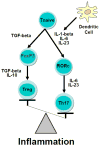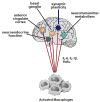Immune system to brain signaling: neuropsychopharmacological implications
- PMID: 21334376
- PMCID: PMC3072299
- DOI: 10.1016/j.pharmthera.2011.01.014
Immune system to brain signaling: neuropsychopharmacological implications
Abstract
There has been an explosion in our knowledge of the pathways and mechanisms by which the immune system can influence the brain and behavior. In the context of inflammation, pro-inflammatory cytokines can access the central nervous system and interact with a cytokine network in the brain to influence virtually every aspect of brain function relevant to behavior including neurotransmitter metabolism, neuroendocrine function, synaptic plasticity, and neurocircuits that regulate mood, motor activity, motivation, anxiety and alarm. Behavioral consequences of these effects of the immune system on the brain include depression, anxiety, fatigue, psychomotor slowing, anorexia, cognitive dysfunction and sleep impairment; symptoms that overlap with those which characterize neuropsychiatric disorders, especially depression. Pathways that appear to be especially important in immune system effects on the brain include the cytokine signaling molecules, p38 mitogen-activated protein kinase and nuclear factor kappa B; indoleamine 2,3 dioxygenase and its downstream metabolites, kynurenine, quinolinic acid and kynurenic acid; the neurotransmitters, serotonin, dopamine and glutamate; and neurocircuits involving the basal ganglia and anterior cingulate cortex. A series of vulnerability factors including aging and obesity as well as chronic stress also appears to interact with immune to brain signaling to exacerbate immunologic contributions to neuropsychiatric disease. The elucidation of the mechanisms by which the immune system influences behavior yields a host of targets for potential therapeutic development as well as informing strategies for the prevention of neuropsychiatric disease in at risk populations.
Copyright © 2011 Elsevier Inc. All rights reserved.
Conflict of interest statement
Figures


Humoral pathway: Pro-inflammatory cytokines released by activated monocytes and macrophages access the brain through leaky regions of the blood-brain barrier such as the choroid plexus and circumventricular organs (CVOs). Within the brain parenchyma, the activation of endothelial cells is responsible for the subsequent release of second messengers (e.g., prostaglandins [PGE2] and nitric oxide [NO]) that act on specific brain targets.
Neural pathway: Pro-inflammatory cytokines released by activated monocytes and macrophages stimulate primary afferent nerve fibers in the vagus nerve. Sensory afferents of the vagus nerve relay information to brain areas through activation of the nucleus of the tractus solitarius (NTS) and area postrema.
Cellular Pathway: A cellular pathway has been recently described by which pro-inflammatory cytokines, notably TNF-alpha, are able to stimulate microglia to produce monocyte chemoattractant protein-1 (MCP-1), which in turn is responsible for the recruitment of monocytes into the brain (D’ Mello et al., 2009).



References
-
- aan het Rot M, Collins KA, Murrough JW, Perez AM, Reich DL, Charney DS, Mathew SJ. Safety and efficacy of repeated-dose intravenous ketamine for treatment-resistant depression. Biol Psychiatry. 2010;67:139–145. - PubMed
-
- Acosta-Rodriguez EV, Napolitani G, Lanzavecchia A, Sallusto F. Interleukins 1beta and 6 but not transforming growth factor-beta are essential for the differentiation of interleukin 17-producing human T helper cells. Nat Immunol. 2007;8:942–949. - PubMed
-
- Akiyama H, Arai T, Kondo H, Tanno E, Haga C, Ikeda K. Cell mediators of inflammation in the Alzheimer disease brain. Alzheimer Dis Assoc Disord. 2000;14(Suppl 1):S47–53. - PubMed
-
- Alexander GE, Crutcher MD, DeLong MR. Basal ganglia-thalamocortical circuits: parallel substrates for motor, oculomotor, “prefrontal” and “limbic” functions. Prog Brain Res. 1990;85:119–146. - PubMed
-
- Anisman H, Ravindran AV, Griffiths J, Merali Z. Endocrine and cytokine correlates of major depression and dysthymia with typical or atypical features. Molecular Psychiatry. 1999;4:182–188. - PubMed
Publication types
MeSH terms
Substances
Grants and funding
LinkOut - more resources
Full Text Sources
Other Literature Sources
Medical

